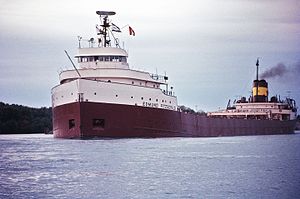Documentary on the “SS Edmund Fitzgerald”

|
|
| History | |
|---|---|
| Name: | SS Edmund Fitzgerald |
| Owner: | Northwestern Mutual Life Insurance Company |
| Operator: | Columbia Transportation Division, Oglebay Norton Company of Cleveland, Ohio |
| Port of registry: | |
| Ordered: | February 1, 1957 |
| Builder: | Great Lakes Engineering Works of River Rouge, Michigan |
| Yard number: | 301 |
| Laid down: | August 7, 1957 |
| Launched: | June 7, 1958 |
| Christened: | June 7, 1958 |
| Maiden voyage: | September 24, 1958 |
| In service: | June 8, 1958 |
| Out of service: | November 10, 1975 |
| Identification: | Registry number US 277437 |
| Nickname(s): | Fitz, Mighty Fitz, Big Fitz, Pride of the American Flag, Toledo Express, Titanic of the Great Lakes |
| Fate: | Lost in a storm on November 10, 1975, with all 29 crewmembers |
| Status: | Sank because of weather conditions |
| Notes: | Location: 46°59.91′N 85°06.61′WCoordinates: 46°59.91′N 85°06.61′W[1] |
| General characteristics | |
| Type: | Lake freighter |
| Tonnage: | |
| Length: |
|
| Beam: | 75 ft (23 m)[3] |
| Draft: | 25 ft (7.6 m) typical |
| Depth: | 39 ft (12 m) (moulded)[4] |
| Depth of hold: | 33 ft 4 in (10.16 m)[4][5] |
| Installed power: |
|
| Propulsion: | Single 19.5 ft (5.9 m) propeller |
| Speed: | 14 kn (26 km/h; 16 mph) |
| Capacity: | 25,400 tons of cargo |
| Crew: | 29 |
SS Edmund Fitzgerald was an American Great Lakes freighter that sank in a Lake Superior storm on November 10, 1975, with the loss of the entire crew of 29. When launched on June 7, 1958, it was the largest ship on North America’s Great Lakes, and she remains the largest to have sunk there.
For seventeen years Fitzgerald carried taconite iron ore from mines near Duluth, Minnesota, to iron works in Detroit, Toledo, and other Great Lakes ports. As a “workhorse,” she set seasonal haul records six times, often breaking her own previous record] Captain Peter Pulcer was known for piping music day or night over the ship’s intercom while passing through the St. Clair and Detroit Rivers (between Lakes Huron and Erie), and entertaining spectators at the Soo Locks (between Lakes Superior and Huron) with a running commentary about the ship. Her size, record-breaking performance, and “DJ captain” endeared Fitzgerald to boat watchers.
Carrying a full cargo of ore pellets with Captain Ernest M. McSorley in command, she embarked on her ill-fated voyage from Superior, Wisconsin, near Duluth, on the afternoon of November 9, 1975. En route to a steel mill near Detroit, Fitz joined a second freighter, SS Arthur M. Anderson. By the next day, the two ships were caught in a severe storm on Lake Superior, with near hurricane–force winds and waves up to 35 feet (11 m) high. Shortly after 7:10 p.m., Fitzgerald suddenly sank in Canadian (Ontario) waters 530 feet (160 m) deep, about 17 miles (15 nautical miles; 27 kilometers) from Whitefish Bay near the twin cities of Sault Ste. Marie, Michigan, and Sault Ste. Marie, Ontario—a distance Fitzgerald could have covered in just over an hour at her top speed. Although Fitzgerald had reported being in difficulty earlier, no distress signals were sent before she sank; Captain McSorley’s last message to Anderson said, “We are holding our own.” Her crew of 29 perished, and no bodies were recovered.
Many books, studies, and expeditions have examined the cause of the sinking. Fitzgerald might have fallen victim to the high waves of the storm, suffered structural failure, been swamped with water entering through her cargo hatches or deck, experienced topside damage, or shoaled in a shallow part of Lake Superior. The sinking of Edmund Fitzgerald is one of the best-known disasters in the history of Great Lakes shipping. Gordon Lightfoot made it the subject of his 1976 hit song “The Wreck of the Edmund Fitzgerald” after reading an article, “The Cruelest Month”, in the November 24, 1975, issue of Newsweek. The sinking led to changes in Great Lakes shipping regulations and practices that included mandatory survival suits, depth finders, positioning systems, increased freeboard, and more frequent inspection of vessels.
Read More Here: SS Edmund Fitzgerald.
Thank You for visiting MaxResistance please like our Facebook and subscribe to our Twitter. If you would like to keep up to date on all our articles please hit the *FOLLOW button at the bottom right of this page and keep up with all our current articles. We ask you to show your support and SHARE our articles and information if you enjoy and like the content. Thank You.
Source Article from http://www.maxresistance.com/november-10-1975-ss-edmund-fitzgerald/
 RSS Feed
RSS Feed















 November 10th, 2015
November 10th, 2015  Awake Goy
Awake Goy 
 Posted in
Posted in  Tags:
Tags: 













